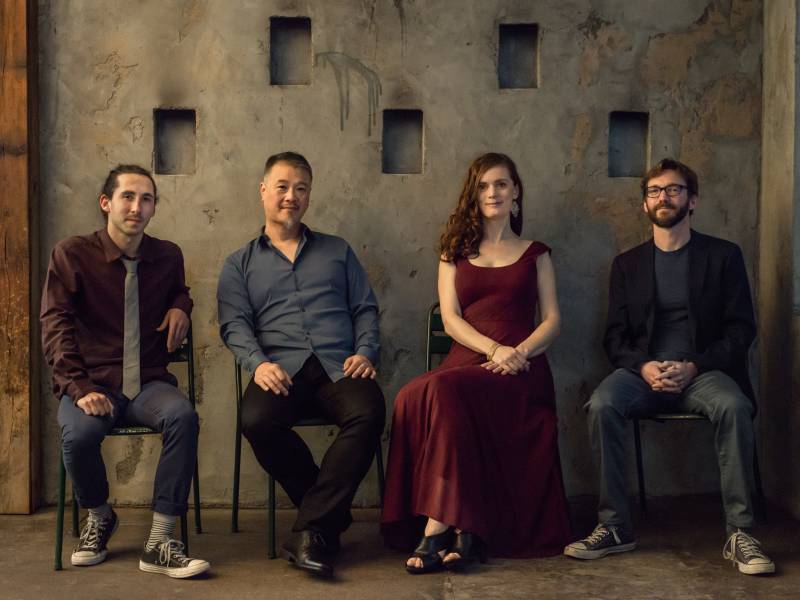The quartet will perform the work with the vocal ensemble Volti on the island on Oct. 23—weather permitting. The world-premiere performance takes place tonight, at San Francisco’s Presidio Theatre.
Lee, a second-generation Chinese immigrant, is from the San Francisco Bay Area. But, he says, he only found out about Angel Island’s immigration history as a college student at the University of California, Berkeley.
“In other parts of the country — and probably even here, to some degree — it’s like you don’t learn anything about this history at all,” Lee says.
Even today, the subject isn’t widely taught in schools. “There are pockets of places and teachers who seek out this sort of content and are teaching it,” says Tuyen Tran, assistant director of the California History-Social Science Project, a University of California Davis group that monitors history teaching and curricula in California K-12 schools. “But is it mandated? No.”
Indeed, many people interviewed for this story, including Chinese-Americans with family members who experienced Angel Island firsthand, talk about the suppression of this history. “When we were interviewing people about their days on Angel Island, my father was adamant that my mother not speak to us,” says Genny Lim, a San Francisco-based Chinese-American poet, educator, playwright and activist, whose mother immigrated via the island. Lim was part of a group of people who first translated the wall poems of Angel Island in the late 1970s and conducted research with people who’d been detained there. They published these poems in the 1980 book, Island: Poetry and History of Chinese Immigrants on Angel Island.
“I’ve been an educator for 20 years — it’s really, really difficult to find people who know much about Angel Island,” says Andi Wong, whose own grandparents came through it.
A bleak history
The bleakness of Angel Island’s history partly explains why many people don’t like to talk about it.
“For the 30 years of operation, this facility, while nicknamed the ‘Ellis Island of the West,’ was called by the people that worked here the ‘Guardian of the Western Gate,’ ” says California State Parks interpreter Casey Dexter-Lee. “And their job was to keep people out.”
Dexter-Lee says the majority of the immigrants who traveled through Angel Island were from places like China, Japan and India. As a result of racist immigration laws, including the 1882 Chinese Exclusion Act, Chinese newcomers faced particularly grueling interrogations and average stays of weeks or even months. Other applicants typically stayed just a couple of days. Dexter-Lee says deportation and appeal rates for Chinese people were also higher. “About 50 percent of Chinese immigrants failed their initial entry hearing,” she says.
After the Second World War, the station was decommissioned and eventually fell into neglect; it was nearly torn down in the 1960s. But in 1970, a visiting park ranger noticed poems carved into the walls which, Dexter-Lee says, sparked interest in preserving the grimy building. Today, it’s a national historic landmark.
“The poems on the walls are what saved this building from destruction,” Dexter-Lee says.
The composer Huang Ruo, who came to the U.S. from China in the 1990s to study music, fell under the spell of Angel Island’s poems after learning about them. That interest eventually led, in 2018, to Ruo and the Del Sol Quartet staging a performance on Angel Island, comprised of music improvised around one of the wall poems.
A musical journey
In a recent interview, Ruo said that the research trip was a visceral journey — he went from regaling in the beautiful outdoor scenery to understanding something of the horror of being confined indoors.
“I feel I could relate being there, looking out from inside,” he says. The music Ruo went on to compose takes the listener on a similar journey.
In addition to calling for musicians to read aloud several historic texts relating to attitudes towards Chinese immigrants — including a list of people killed in the Chinese Massacre of 1871 in Los Angeles and the anti-Chinese Page Act of 1875 — the work sets three of the Angel Island wall poems.
The arc of the piece follows a hopeful immigrant’s experience of traveling to America, through the shattering of hope as a detainee stuck for months on Angel Island, to a prisoner’s final, hopeless death on the island.
“The third poem is a funeral poem,” Ruo says. “Someone died, and this person’s friend carved a poem on the wall to mourn his friend: how his will was not fulfilled by coming this far, how he lays under the cold clay and mud.”
Connecting the past with the present
Though Angel Island is steeped in historical material, the work carries resonance today.
“There’s nothing new about this treatment of immigrants,” says Wong, who in addition to being an “Angel Island descendant” herself, is managing the community outreach effort around the new musical work, such as public discussions and a community photography exhibition aimed at connecting Angel Island’s past with our own times. “It comes in waves.”
Wong’s grandmother came through Angel Island in 1929. Wong says her grandfather, who had already immigrated, was forced to pay a fee of $1,000 (around $16,000 in today’s money) for his wife’s release.
“She would have been sent back,” says Wong in response to the question of what would have happened to her grandmother, then pregnant with her father, if that fee hadn’t been paid. “So I wouldn’t be standing here, talking to you.”
Wong says this country’s attitude towards many immigrants hasn’t improved much since then — what with the ongoing issues at the U.S.-Mexico border, and the lack of leniency towards Haitian asylum seekers today. Plus, the waves of attacks against Asian immigrants and their descendants haven’t gone away since the earliest days of Chinese immigration here.
And that’s where art comes in: Wong says works like Angel Island can help us reconnect with the past in a new way.



9(MDAxOTAwOTE4MDEyMTkxMDAzNjczZDljZA004))

